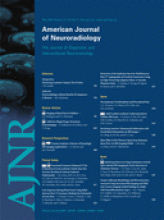Research ArticleResearch Perspectives
Open Access
Texture Analysis: A Review of Neurologic MR Imaging Applications
A. Kassner and R.E. Thornhill
American Journal of Neuroradiology May 2010, 31 (5) 809-816; DOI: https://doi.org/10.3174/ajnr.A2061

References
- 1.↵
- Anderson RE,
- Hill RB,
- Key CR
- 2.↵
- Engelhardt HT Jr.,
- Callahan D
- Gorovitz S,
- MacIntyre A
- 3.↵
- Kaizer H
- 4.↵
- Darling EM,
- Joseph RD
- 5.↵
- Hall EE,
- Kruger RP,
- Dwyer SJ,
- et al
- 6.↵
- Chien YP,
- Fu KS
- 7.↵
- 8.↵
- Tourassi GD
- 9.↵
- Haralick RM,
- Shanmugam K,
- Dinstein I
- 10.↵
- Julesz B,
- Gilbert EN,
- Shepp LA
- 11.↵
- Seppä M,
- Hämäläinen M
- 12.↵
- 13.↵
- Galloway MM
- 14.↵
- Weszka JS,
- Dyer CR,
- Rosenfeld A
- 15.↵
- Conners RW,
- Harlow CA
- 16.↵
- Tang X
- 17.↵
- 18.↵
- Zhu H,
- Goodyear BG,
- Lauzon ML,
- et al
- 19.↵
- Mallat SG
- 20.↵
- Gabor D
- 21.↵
- Daubechies I
- 22.↵
- Stockwell RG
- 23.↵
- Zhang J,
- Tong L,
- Wang L,
- et al
- 24.↵
- Mayerhoefer ME,
- Breitenseher MJ,
- Kramer J,
- et al
- 25.↵
- 26.↵
- Hsu S-Y
- 27.↵
- Cover TM,
- Hart PE
- 28.↵
- Georgiadis P,
- Cavouras D,
- Kalatzis I,
- et al
- 29.↵
- 30.↵
- Georgiadis P,
- Cavouras D,
- Kalatzis I,
- et al
- 31.↵
- 32.↵
- Jain AK,
- Duin RPW
- 33.↵
- 34.↵
- Earnest FT,
- Kelly PJ,
- Scheithauer BW,
- et al
- 35.↵
- Herlidou-Même S,
- Constans JM,
- Carsin B,
- et al
- 36.↵
- Provenzale JM,
- Mukundan S,
- Barboriak DP
- 37.↵
- Mahmoud-Ghoneim D,
- Toussaint G,
- Constans JM,
- et al
- 38.↵
- Brown R,
- Zlatescu M,
- Sijben A,
- et al
- 39.↵
- 40.↵
- 41.↵
- Barkovich AJ,
- Kuzniecky RI
- 42.↵
- Avoli M,
- Bernasconi A,
- Mattia D,
- et al
- 43.↵
- Bernasconi A,
- Antel SB,
- Collins DL,
- et al
- 44.↵
- 45.↵
- 46.↵
- Sankar T,
- Bernasconi N,
- Kim H,
- et al
- 47.↵
- 48.↵
- Freeborough PA,
- Fox NC
- 49.↵
- Weinshenker BG,
- Bass B,
- Rice GPA,
- et al
- 50.↵
- Rovaris M,
- Confavreux C,
- Furlan R,
- et al
- 51.↵
- Wolinsky JS
- 52.↵
- Yu O,
- Mauss Y,
- Zollner G,
- et al
- 53.↵
- Li DK,
- Paty DW
- 54.↵
- Zhang Y,
- Zhu H,
- Mitchell JR,
- et al
- 55.↵
- Schmierer K,
- Scaravilli F,
- Altmann DR,
- et al
- 56.↵
- van Buchem MA,
- McGowan JC,
- Kolson DL,
- et al
- 57.↵
- Davies GR,
- Altmann DR,
- Hadjiprocopis A,
- et al
- 58.↵
- Tozer DJ,
- Marongiu G,
- Swanton JK,
- et al
- 59.↵
- Breij EC,
- Brink BP,
- Veerhuis R,
- et al
- 60.↵
- Hacke W,
- Kaste M,
- Bluhmki E,
- et al
- 61.↵
- 62.↵
- 63.↵
- Roberts H,
- Roberts T,
- Brasch R,
- et al
- 64.↵
- Tofts P,
- Kermode A
- 65.↵
- 66.↵
- Kassner A,
- Roberts T,
- Taylor K,
- et al
- 67.↵
- Kassner A,
- Roberts TPL,
- Moran B,
- et al
- 68.↵
- Theocharakis P,
- Glotsos D,
- Kalatzis I,
- et al
- 69.↵
In this issue
Advertisement
A. Kassner, R.E. Thornhill
Texture Analysis: A Review of Neurologic MR Imaging Applications
American Journal of Neuroradiology May 2010, 31 (5) 809-816; DOI: 10.3174/ajnr.A2061
0 Responses
Jump to section
Related Articles
Cited By...
- Comprehensive Evaluation of Human Donor Liver Viability with Polarization-Sensitive Optical Coherence Tomography
- Leveraging Hand-Crafted Radiomics on Multicenter FLAIR MRI for Predicting Disability Progression in People with Multiple Sclerosis
- Deep-Learning Convolutional Neural Networks Accurately Classify Genetic Mutations in Gliomas
- Radiomics in Brain Tumor: Image Assessment, Quantitative Feature Descriptors, and Machine-Learning Approaches
- CT Texture Analysis Potentially Predicts Local Failure in Head and Neck Squamous Cell Carcinoma Treated with Chemoradiotherapy
- Metrics and Textural Features of MRI Diffusion to Improve Classification of Pediatric Posterior Fossa Tumors
This article has been cited by the following articles in journals that are participating in Crossref Cited-by Linking.
- Stefan Bauer, Roland Wiest, Lutz-P Nolte, Mauricio ReyesPhysics in Medicine and Biology 2013 58 13
- P. Chang, J. Grinband, B.D. Weinberg, M. Bardis, M. Khy, G. Cadena, M.-Y. Su, S. Cha, C.G. Filippi, D. Bota, P. Baldi, L.M. Poisson, R. Jain, D. ChowAmerican Journal of Neuroradiology 2018 39 7
- M. Zhou, J. Scott, B. Chaudhury, L. Hall, D. Goldgof, K.W. Yeom, M. Iv, Y. Ou, J. Kalpathy-Cramer, S. Napel, R. Gillies, O. Gevaert, R. GatenbyAmerican Journal of Neuroradiology 2018 39 2
- Maider Vidal, José Manuel AmigoChemometrics and Intelligent Laboratory Systems 2012 117
- Nishant Verma, Matthew C. Cowperthwaite, Mark G. Burnett, Mia K. MarkeyNeuro-Oncology 2013 15 5
- Vishwa Parekh, Michael A. JacobsExpert Review of Precision Medicine and Drug Development 2016 1 2
- Brian L. DeCost, Elizabeth A. HolmComputational Materials Science 2015 110
- Taryn Hodgdon, Matthew D. F. McInnes, Nicola Schieda, Trevor A. Flood, Leslie Lamb, Rebecca E. ThornhillRadiology 2015 276 3
- P. Mohamed Shakeel, Tarek E. El. Tobely, Haytham Al-Feel, Gunasekaran Manogaran, S. BaskarIEEE Access 2019 7
- Carlo N. De Cecco, Balaji Ganeshan, Maria Ciolina, Marco Rengo, Felix G. Meinel, Daniela Musio, Francesca De Felice, Nicola Raffetto, Vincenzo Tombolini, Andrea LaghiInvestigative Radiology 2015 50 4
More in this TOC Section
Similar Articles
Advertisement











